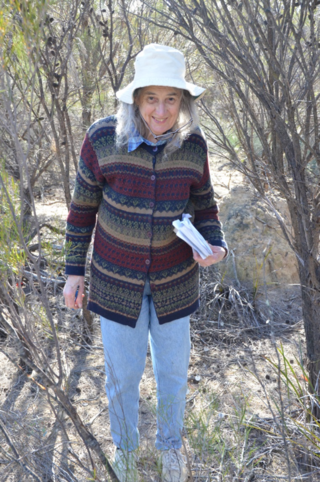
The Mygalomorphae, or mygalomorphs, are an infraorder of spiders, and comprise one of three major groups of living spiders with over 3000 species, found on all continents except Antarctica. Many members are known as trapdoor spiders due to their creation of trapdoors over their burrows. Other prominent groups include Australian funnel web spiders and tarantulas, with the latter accounting for around one third of all mygalomorphs.

The family Cyrtaucheniidae, known as wafer-lid trapdoor spiders, are a widespread family of Mygalomorphae spiders.
Rugose means "wrinkled". It may refer to:

Missulena is a genus of mygalomorph spiders in the family Actinopodidae. It was first described by Charles Walckenaer in 1805, and is a senior synonym of Eriodon. M. tussulena is found in Chile, but the rest are indigenous to Australia. They are sometimes referred to as "mouse spiders" from the now-disproven belief that they dig deep burrows similar to those of mice. Scotophaeus blackwalli is also called a "mouse spider", but it is smaller and not closely related.

Idiopidae, also known as armored or spiny trapdoor spiders, is a family of mygalomorph spiders first described by Eugène Simon in 1889.

Barychelidae, also known as brushed trapdoor spiders, is a spider family with about 300 species in 42 genera.

Idiosoma is a genus of Australian armoured trapdoor spiders that was first described by Anton Ausserer in 1871. Originally placed with the Ctenizidae, it was moved to the armoured trapdoor spiders in 1985. The name is derived from the Greek ἴδιος, meaning "individual, unique", and σῶμα, meaning "body", referring to the distinctive structure of the abdomen.
Bertmainius tingle, also called the tingle trapdoor spider, is a small basal spider endemic to the tingle and karri forest of southwestern Western Australia. This migid family species of Bertmainius was first recorded in the 1990s.

Australia has a number of highly venomous spiders, including the Sydney funnel-web spider, its relatives in the family Hexathelidae, and the redback spider, whose bites can be extremely painful and have historically been linked with deaths in medical records. Most Australian spiders do not have venom that is considered to be dangerously toxic. No deaths caused by spider bites in Australia have been substantiated by a coronial inquest since 1979. There are sensationalised news reports regarding Australian spiders that fail to cite evidence. A Field Guide to Spiders of Australia published by CSIRO Publishing in 2017 featuring around 836 species illustrated with photographs of live animals, around 381 genera and 78 families, introduced significant updates to taxonomy from Ramirez, Wheeler and Dmitrov

Barbara Anne York Main was an Australian arachnologist and adjunct professor at the University of Western Australia. The author of four books and over 90 research papers, Main is recognised for her prolific work in establishing taxonomy for arachnids, personally describing 34 species and seven new genera. The BBC and ABC produced a film about her work, Lady of the Spiders, in 1981.

Gaius is a genus of large mygalomorph spiders in the family Idiopidae. Erected in 1914 by William Joseph Rainbow, for much of its history the genus contained only one species, Gaius villosus. More species were added in 2018. All are endemic to Western Australia.
Idiosoma castellum is a trapdoor spider in the Arbanitinae subfamily of the Idiopidae family. It was first described as Aganippe castellum by Barbara York Main in 1986. In 2017 Michael Rix and others transferred it to the genus, Idiosoma, to give the name Idiosoma castellum,.
Idiosoma cupulifex is a trapdoor spider in the Arbanitinae subfamily of the Idiopidae family. It was first described as Aganippe cupulifex by Barbara York Main in 1957. In 2017 Michael Rix and others transferred it to the genus, Idiosoma, to give the name Idiosoma cupulifex,.

Idiosoma arenaceum is a trapdoor spider in the Arbanitinae subfamily of the Idiopidae family. It was first described in 2018 by Michael G. Rix, Mark Harvey and others.

Idiosoma clypeatum is a trapdoor spider in the Arbanitinae subfamily of the Idiopidae family. It was first described in 2018 by Michael G. Rix, Mark Harvey and others.
Bungulla riparia is a species of mygalomorph spider in the Idiopidae family. It is endemic to Australia. It was described in 1957 by Australian arachnologist Barbara York Main.

Idiosoma sigillatum is a species of mygalomorph spider in the Idiopidae family. It is endemic to Australia. It was described in 1870 by British arachnologist Octavius Pickard-Cambridge.
Idiosoma subtriste is a species of mygalomorph spider in the Idiopidae family. It is endemic to Australia. It was described in 1877 by British arachnologist Octavius Pickard-Cambridge.













